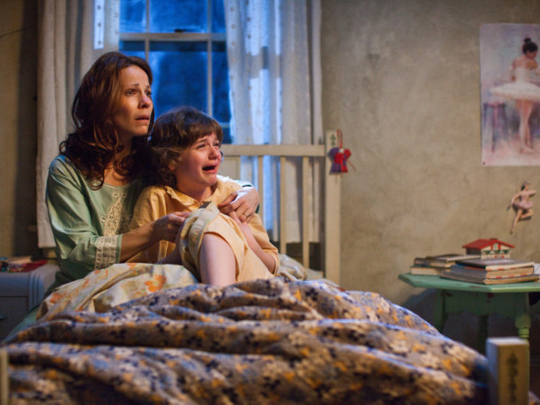
As sympathetic, methodical ghostbusters Lorraine and Ed Warren, Vera Farmiga and Patrick Wilson make the old-fashioned haunted-house horror film The Conjuring something more than your average fright fest.
In 1971, they come to the Perrons’ swampy, musty Rhode Island farmhouse — newly purchased from the bank — to investigate the demonic spirit that has begun terrorising the couple and their five daughters — a working class family who thought they had clawed their way into a rustic dream house.
Lorraine is clairvoyant, and Ed is a Vatican-sanctioned demonologist. They’re best known as the married, devoutly Catholic paranormal pros whose work with the Lutz family served as the basis for Amityville Horror. The Conjuring, which boasts incredulously of being their most fearsome, previously unknown case, is built very much in the ‘70s-style mould of Amityville and, if one is kind, The Exorcist. The film opens with a majestic, foreboding title card that announces its aspirations to such a lineage.
Does it live up to that? More than most horror films, certainly. But as effectively crafted as The Conjuring is, it’s lacking the raw, haunting power of the models it falls shy of. The Exorcist is a high standard, though The Conjuring is an unusually sturdy piece of haunted-house genre filmmaking.
The director is James Wan, who’s best known as one of the founding practitioners of that odious type of horror film called “torture porn” (Saw). In The Conjuring, he goes classical. Though it comes across as a self-conscious stab at more traditional, floorboard-creaking horror, Wan has succeeded in patiently building suspense (of which there is plenty) not out of bloodiness, but those old standbys of slamming doors and flashes in the mirror.
Roger Perron (Ron Livingston) and his wife Carolyn (Lili Taylor) aren’t initially suspicious when their clocks all stop at 3.07am, the family dog — as is custom — turns up dead and one of the girls starts sleepwalking. But the torment grows — bruises appear on Carolyn’s arms, the children are visited at night — they seek out the Warrens, whom we first see lecturing on the science of the supernatural.
They, too, have a daughter. Their general philosophy is that a demonic spirit can attach itself to a person or an object, like a tick or unpaid parking tickets. They keep a sealed-off chamber of possessed items (a spooky doll figures prominently, of course), something like a trophy room of evil.
Chad Hayes and Carey W. Hayes’ screenplay smoothly melds the story lines of both families. Particularly good is Julie Berghoff’s production design, a necessity for a film that spends so much time in one setting. Cinematographer John R. Leonetti’s camera creeps slowly through the house.
The Conjuring shows its flaws, though, in its occasional digital effects representing the demons. Such choices effectively break the careful, naturalistic atmosphere Wan has created. The filmmakers have told stories of brushes with the supernatural while making the film, which only further contributes to the feeling that The Conjuring is too busy overstating its verisimilitude to have anything else on its mind.
But most effecting are Wilson and the wonderful, sad-eyed Farmiga. When the Perrons are in need, the Warrens come with their instruments and understanding, ready to help a family haunted by an unseen demon.












